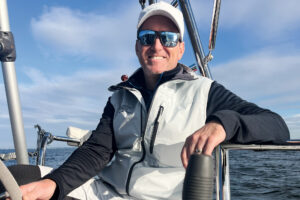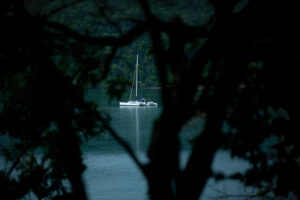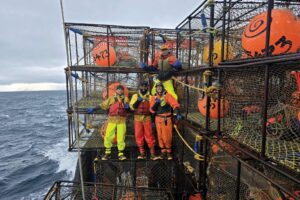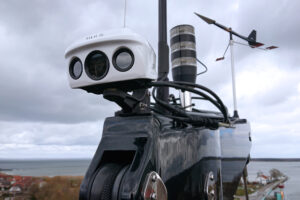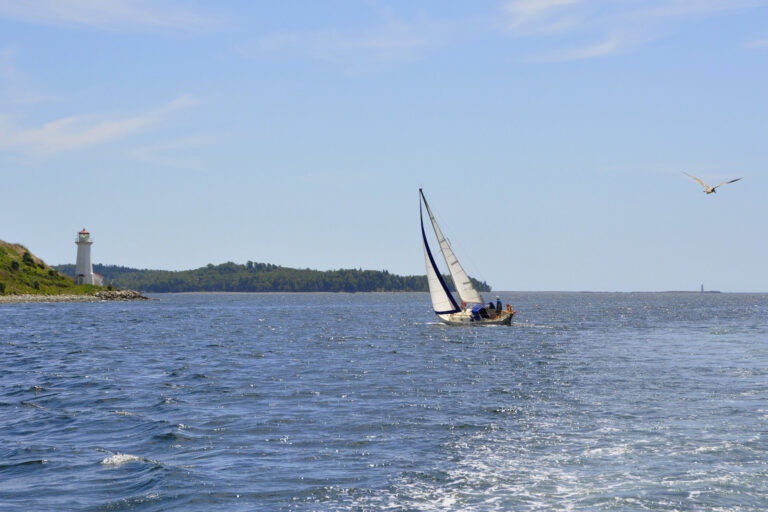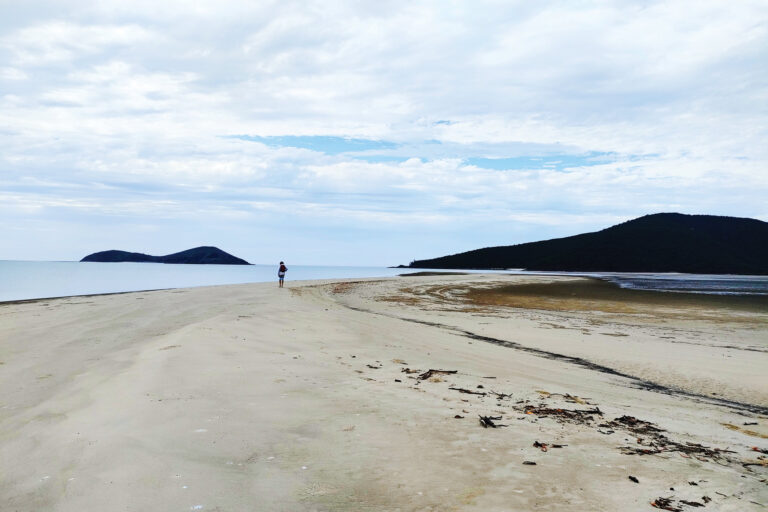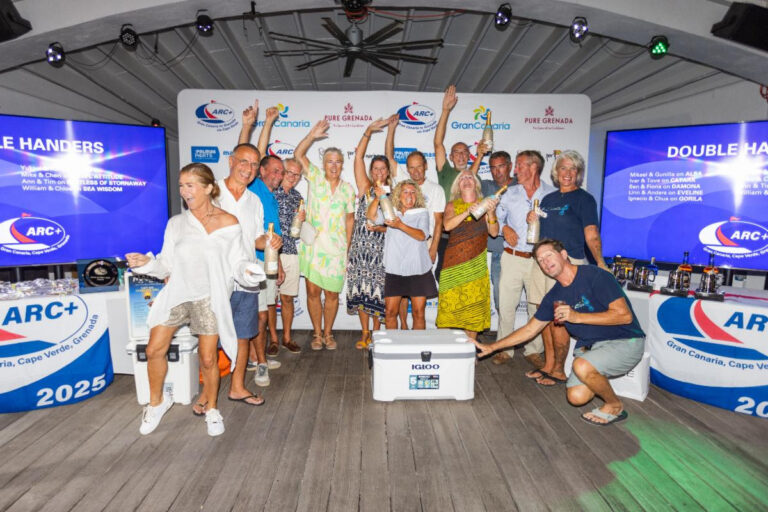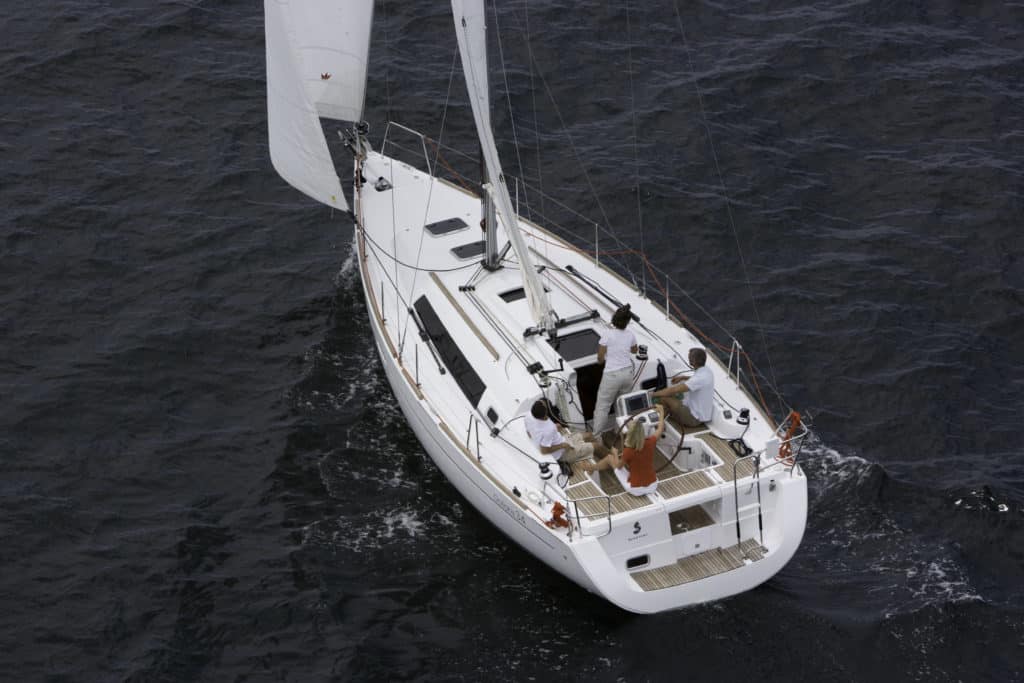
The featherlight feel of the large, leather-covered wheel in no way reflected the Beneteau 34’s relatively moderate displacement as we danced to weather on a blustery day on Narragansett Bay. Overcanvased under full sail, we heeled when the breeze was on, but not too far. The 6-foot-deep cast-iron keel and bulb kept the center of gravity low, and the fairly hard turn to the bilge provided form stability; together, they conspired to keep the Beneteau 34 on its feet.
Dropping the cabin-top traveler took care of any inclination for the boat to round up in the 20-knot puffs. The 34 pointed well and easily made 6 knots on the wind. That jumped to around 7 when we eased sheets and bore off.
The crowded harbor at Newport, Rhode Island, proved a good place to test the Beneteau 34’s maneuverability under power. The boat passed with flying colors, turning on a dime and backing straight thanks to the balanced spade rudder. When we got to the harbor mouth, we cruised at about 6.5 knots wide open.
Sailing and powering, the boat felt solid; it should, as it boasts an integral fiberglass grid/hull liner bonded to a solid-glass hull, bulkheads bonded 360 degrees to the hull and deck, and a deck cored with resin-infused end-grain balsa. The fiberglass rudder on its stainless-steel stock with Goïot cable-and-quadrant steering provided guidance with the flick of a finger and with no groan of complaint.
The deck layout on the Beneteau 34 offers easy egress over the coamings from the cockpit and wide decks and sure footing for sailors heading to the bow. On the boat I sailed, teak toerails ran down both sides, and fairly aggressive nonskid wrapped up onto the cabin top, where teak handrails ran forward to the mast. Wayne Burdick, president of Beneteau USA, says that the use of teak is being phased out, though, in favor of more sustainable managed-forestry woods, such as iroko.
The deck-stepped 9/10ths rig is by US Spars and features swept double spreaders; wire rigging is led to outboard chainplates. The jib is set on a Profurl furler, and while the boat I sailed had a traditional hoist main (a $1,000 option), a furling main and jib from Neil Pryde are standard.
Wraparound cockpit seats provide lots of options; the helmsman can perch to either side of the wheel with a good view of the telltales and easily trim the standard 105-percent jib on the primary winch or sit directly behind the wheel and watch the optional chart plotter in its built-in pod on the pedestal. For the crew, the angled deckhouse bulkhead makes a comfortable backrest.
The center of the aft seat lifts to permit easy access to the swim platform; just to port, there’s an area under the large lift-up seat section that’s for life-raft stowage. A plastic basket of some sort could turn this into usable storage space with no raft aboard. Next to this area is a separate vented propane locker. A capacious seat locker on the starboard side of the cockpit is shallow enough that a sailor grabbing stowed equipment doesn’t have to do a head stand to reach into the bilge.
Typical for a boat this size, a winch on the cabin top to port of the companionway does yeoman’s duty controlling halyards, vang, outhaul (on boats equipped with the furling main), and mainsheet. This keeps the clutter of lines on the cabin top, but it means the skipper must leave the wheel to trim the mainsail.
The companionway has an arrangement borrowed from other Beneteaus that allows the drop boards to slide up and stow under the sliding hatch while they’re not in use; on stormy days, they can be left in place and the hatch slid open for ventilation.
Below, the interior by Nauta Design feels big for a 34-footer. And so it should: The boat has a more than 3-to-1 length-to-beam ratio that maxes out at the companionway and carries almost all the way aft. To starboard of the companionway steps is the roomy head. The gelcoat finish will be easy to keep clean, and three ports-two opening-provide more than adequate light and ventilation. Opposite, the galley features a two-burner stove and oven and an aft-opening refrigerator. A double sink sits close to the centerline. Aft of the galley lies a cabin with a huge athwartships double berth. There’s an aft-facing opening port in the transom to ensure flow-through ventilation. Forward is a hanging locker, another couple of opening ports, and access to the side of the engine.
The saloon is palatial for a boat of this length, and ports and hatches keep it light and airy, as does the golden Alpi woodwork (another sustainable-wood product) set off by the light upholstery. Settees are long and wide enough to be sea berths with the addition of lee cloths. Lockers outboard will ease stowing headaches before a long cruise, though the shelves above would benefit from better fiddles. The table leaves fold up to serve five or six. There could be more handholds in the saloon, but there are places to brace against when moving about.
A good-size V-berth dominates the forward cabin, with a hanging locker to starboard, shelves to either side, and lockers to port that will provide plenty of space for those who don’t pack too much.
Given the costs that go into boat construction, this commodious little rocket, with a price tag of right around $150,000 for a boat that’s ready to sail and commissioned on the U.S. East Coast, has earned its designation by CW’s Boat of the Year judges as the Best Value cruiser for 2009. There’s a lot of boat and a lot of performance here for the money.
Andrew Burton is CW’s associate editor. A boat review from our May 2009 issue
Specs
LOA 33′ 11″ (10.34 m.)
LWL 30′ 8″ (9.35 m.)
Beam 12′ 0″ (3.66 m.)
Draft (shoal/deep) 4′ 6″/6′ 1″ (1.37/1.85 m.)
Sail Area (100%) 544 sq. ft. (50.2 sq. m.)
Ballast 3,556/3,208 lb.
(1,613/1,455 kg.)
Displacement 12,569 lb. (5,700 kg.)
Ballast/D .28/.26
D/L 195
SA/D 16.1
Water 83 gal. (314 l.)
Fuel 34 gal. (129 l.)
Mast Height 50′ 8″ (15.44 m.)
Engine 29-hp. Yanmar
Designer Finot-Conq/Nauta Design
Sailaway Price $145,000
Beneteau
(843) 629-5300
To read more Cruising World reviews of Beneteau sailboats, click here. To visit Beneteau America’s website, click here.

